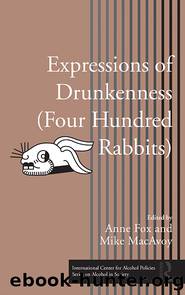Expressions of Drunkenness (Four Hundred Rabbits) by Fox Anne;MacAvoy Mike;

Author:Fox, Anne;MacAvoy, Mike;
Language: eng
Format: epub
Tags: Behavioral Sciences
Publisher: Taylor & Francis Group
Published: 2010-08-11T00:00:00+00:00
group-bonding and mate-attracting rituals within the modern-day hunting grounds of the city center. Among human groups, there will always be a need and drive for communal expressions of joy, solidarity, male competition, rituals of mate selection and sexual signaling, young peopleâs desire for rites of passage and achievement of adult status, and facilitators (whether through custom or substances) for group bonding. When these are absent, uncontrolled, or made unacceptable, alcohol misuse is nearly inevitable.
Alcohol consumption provides a type case for the biosocial study of social action (see Figure 3.2). It involves a natural substance, culturally modified and ingested in customary ways, with well-known physical effects on the brain and physiology of partakers. The partakersâ response, however, is determined in culturally prescribed ways by a combination of the brain effects and custom-directed pressuresâthis produces drunken behavior, which, through individual agency, then reacts back on the social group and affects its cultural values and practices. As this process moves through time, it becomes the history of alcohol consumption. As few of the points in this process are static (including, in the past, ecological availability of the substance and, in modern time, the variety of available substances), the whole social tableau moves through time like a ship dragging anchors. Drinking cultures do shift, but not necessarily though the alteration of any one anchor point in this dynamic process. The effects of alcohol on the brain cannot be treated as a kind of âblack boxâ that can explain all behavioral effects and actions. Above a certain instinctive level, human behavior is entirely dependent on the information going through the brain, the learned patterns, the expectations, and the beliefsâall of which shape drunkenness.
Throughout this chapter, we have looked at drunkenness as an important social communicator, used for bonding, relief of stress, and promotion of group solidarity. To understand drunkenness in human society, we must understand, on the one hand, our acquired evolutionary predispositionsâuniversal constants, the human needs, the adapted mental and emotional capacities and predispositions that we haveâand, on the other, the particular historical and cultural contexts and circumstances of drinking. We, in fact, know a great deal about both; the insights lie in the interplay between the two. Unfortunately, the anthropological voice gets lost amid monocausal notions about the âinevitableâ results of drinking and the relationship between alcohol and behavior. Alcohol encapsulates our most ancient and deep-rooted longings for safety, belonging, praise, transformation, and joy. Drunkenness is an ancient lament.
CASE STUDY 3.1: The Round: Alcohol and Social ConnectionâAn Anthropological Approach
Download
This site does not store any files on its server. We only index and link to content provided by other sites. Please contact the content providers to delete copyright contents if any and email us, we'll remove relevant links or contents immediately.
Unwinding Anxiety by Judson Brewer(72694)
The Art of Coaching by Elena Aguilar(52865)
The Fast Metabolism Diet Cookbook by Haylie Pomroy(21037)
Rewire Your Anxious Brain by Catherine M. Pittman(18508)
Healthy Aging For Dummies by Brent Agin & Sharon Perkins RN(16983)
Talking to Strangers by Malcolm Gladwell(13161)
The Art of Thinking Clearly by Rolf Dobelli(10166)
Crazy Rich Asians by Kevin Kwan(9143)
Mindhunter: Inside the FBI's Elite Serial Crime Unit by John E. Douglas & Mark Olshaker(9133)
The Compound Effect by Darren Hardy(8760)
Tools of Titans by Timothy Ferriss(8176)
Periodization Training for Sports by Tudor Bompa(8122)
Becoming Supernatural by Dr. Joe Dispenza(8064)
Wonder by R. J. Palacio(7914)
Crystal Healing for Women by Mariah K. Lyons(7838)
Bodyweight Strength Training by Jay Cardiello(7821)
Therapeutic Modalities for Musculoskeletal Injuries, 4E by Craig R. Denegar & Ethan Saliba & Susan Saliba(7675)
Change Your Questions, Change Your Life by Marilee Adams(7589)
Should I Stay or Should I Go? by Ramani Durvasula(7535)
